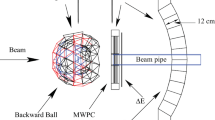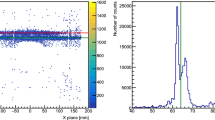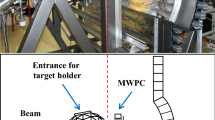Abstract
The present knowledge of nuclear forces is not sufficient to describe all experimental data for systems which consist of more than two nucleons. Recent three-nucleon scattering experiments have shown that the theoretical models based solely on nucleon-nucleon potentials fail to describe most of the experimental results. In this paper, we present data of the \(\vec {p}+d \longrightarrow p+p+n \) break-up reaction that were obtained using a 190 MeV polarized-proton beam impinging on a liquid deuterium target. The experiment was performed by exploiting BINA (Big Instrument for Nuclear-polarization Analysis), a detector system with a large angular acceptance and a high energy resolution.
Access provided by Autonomous University of Puebla. Download conference paper PDF
Similar content being viewed by others
1 Introduction
The nature of the nuclear force is still not well understood. Two-nucleon force (2NF) models, most of which proposed based on Yukawa theory [1], deliver a superb description for nucleon-nucleon scattering data and the characteristics of the deuteron whereas, calculations based on the 2NF models underestimate the experimental results of the three-body system such as the binding energy of the triton [2] and show deviation when comparing their results with measured 3-body scattering cross sections. Therefore, 2NFs are not sufficient to describe three-nucleon systems and we need to take into account three-nucleon force (3NF) effects in the models. There are various 3NFs most of which are based on the model which is developed by Fujita-Miyazawa [3]. In these models, the 2\(\pi \)-exchange mechanism is used with an additional \(\Delta \) excitation of one of the nucleons [4].
In the last two decades, a large number of scattering experiments have been performed to study 3NF effects by measuring differential cross sections and spin observables such as analyzing powers [5, 6]. The 3-body break-up reaction is one of the best tools to study 3NFs thanks to the rich kinematical phase space which allows us to check 3NF at different kinematical configurations.
A comprehensive study of 3NFs has been started at KVI using various beam energies and targets with the aim of measuring differential cross sections and analyzing powers [5,6,7]. The experimental setup (BINA), as it is shown in the left panel of Fig. 56.1, consists of two main parts: a forward-wall and a backward-ball. In this paper, results of measurements of the vector analyzing powers for the proton-deuteron break-up reaction using a 190 MeV proton beam are presented for a part of phase space which has not been explored before [8]. This part of the phase space represents kinematics in which one proton scatters to the forward-wall and the other to the backward-ball. As it is demonstrated in the right panel of Fig. 56.1, the position of each ball detector has been used to measure the scattering angles of protons in the backward-ball and therefore, the angular resolution is around \(\pm 10^{\circ }\).
2 Analysis Method
In the three-body breakup reaction, it is sufficient to measure 5 of the 9 kinematical variables in order to have all the information of the reaction. BINA is able to measure energy and scattering angles of two protons in coincidence, which provides an extra redundancy for extra check. Conventionally, in 3-body break-up reactions, kinematics are specified by the scattering angles of two protons (\(\theta _{1},\theta _{2},\phi _{12}=\phi _{2}-\phi _{1}\)). The left panel of Fig. 56.2 shows the energy correlation of the two protons and the solid line represents the expected energy correlation based on the relativistic kinematics for a particular configuration. This curve is referred to as the S-curve. The value of the variable S is defined as the arc length of the S-curve which is starting from the minimum of \(E_{2}\). Commonly, the breakup observables are presented as a function of the variable S for a given angle combination.
The left panel shows the energy correlation of the two protons for kinematical configuration (\(\theta _{1}=25^{\circ }\pm 2^{\circ },\theta _{2}=127^{\circ }\pm 10^{\circ },\phi _{12}=160^{\circ }\pm 10^{\circ }\)) and detector number 129, together with the expected kinematical S-curve. The right panel shows the missing-mass spectrum of the neutron for one of the gates alongside the S-curve (shown in the left panel)
It is well known that the interaction of a polarized beam with an unpolarized target provides an azimuthal asymmetry in the scattering cross section which is given by [9]:
where \(N^{\uparrow } (N^{\downarrow })\) and \(p_{z}^{\uparrow } (p_{z}^{\downarrow })\) are the cross section and beam polarization for up (down) mode, respectively, \({A_{x}}\) and \({A_{y}}\) are the vector analyzing powers, and \(\phi \) is the azimuthal scattering angle of one the protons. The vector analyzing powers have been obtained for each configuration and ball detector. To get the final results, a weighted averaging has been applied over the ball detectors which are located at the same polar angle.
3 Results and Discussions
The analysis has been done for 48 kinematical configurations and in Fig. 56.3, as representative examples, the preliminary results of vector analyzing powers are shown for some kinematical configurations together with the results of Faddeev calculations using the CD-Bonn and AV18 two-nucleon potentials, with and without the inclusion of two different types of 3NFs. The calculations are performed for the kinematical configuration based on the center of each angular bins. To have a more accurate prediction and considering the fact that the angular resolution is around \(10^\circ \), we should average the calculations over all covered kinematical configurations within an angular bin. This work is in progress. As observed in Fig. 56.3, the effects of the 3NF seem to be rather small for the configurations shown.
References
Yukawa, H.: Proc. Phys. Math. Soc. Jpn. 17, 48 (1935)
Pieper, S.C., Wiringa, R.B.: Ann. Rev. Nucl. Part. Sci. 51, 53 (2001)
Fujita, J., Miyazawa, H.: Prog. Theor. Phys. 17, 360 (1957)
Deltuva, A., Machleidt, R., Sauer, P.U.: Phys. Rev. C 68, 024005 (2003)
Kalantar-Nayestanaki, N., et al.: Rep. Prog. Phys. 75, 016301 (2012)
Kistryn, St., Stephan, E.: J. Phys. G: Nucl. Part. Phys. 40, 063101 (2013)
Mehmandoost-Khajeh-Dad, A.A., et al.: Eur. Phys. J. A 47, 59 (2011)
Mardanpour, H., et al.: Phys. Lett. B 149, 687 (2010)
Ohlsen, G.G., et al.: Nucl. Instrum. Methods. 179, 283 (1981)
Author information
Authors and Affiliations
Corresponding author
Editor information
Editors and Affiliations
Rights and permissions
Copyright information
© 2020 Springer Nature Switzerland AG
About this paper
Cite this paper
Mohammadi-Dadkan, M. et al. (2020). Three-Nucleon Force Studies in Proton-Deuteron Break-Up Reaction with BINA at 190 MeV. In: Orr, N., Ploszajczak, M., Marqués, F., Carbonell, J. (eds) Recent Progress in Few-Body Physics. FB22 2018. Springer Proceedings in Physics, vol 238. Springer, Cham. https://doi.org/10.1007/978-3-030-32357-8_56
Download citation
DOI: https://doi.org/10.1007/978-3-030-32357-8_56
Published:
Publisher Name: Springer, Cham
Print ISBN: 978-3-030-32356-1
Online ISBN: 978-3-030-32357-8
eBook Packages: Physics and AstronomyPhysics and Astronomy (R0)







